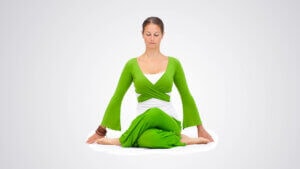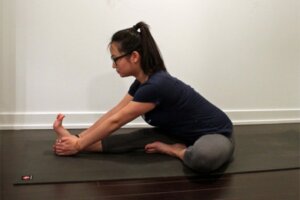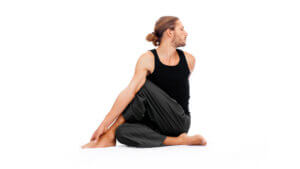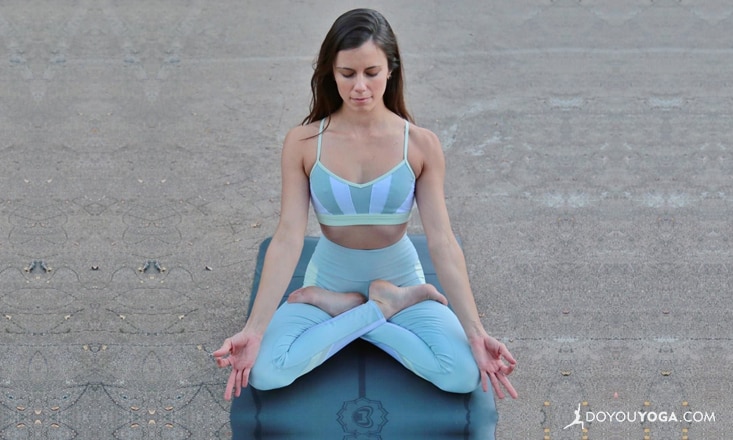Padmasana, or Lotus pose, is a seated pose for meditation and relaxation in yoga. Padma means “lotus” and refers to this auspicious symbol in many yoga teachings.
The lotus flower symbolizes enlightenment, rebirth, beauty, and renewal. It is often depicted in pictures of Hindu deities; Lakshmi, Ganesha, and Lord Vishnu are often shown sitting on an open lotus. It is said that wherever the Buddha walked, lotus flowers bloomed.
In Padmasana, you cross your legs and place your feet in the crooks of your hips, resembling the folded petals of the lotus flower. While the concept of Padmasana sounds simple, the posture is considered advanced. Achieving Padmasana does not make you a better yogi or more spiritual person, but it does offer some benefits to those who can find comfort in the posture.
Benefits of Lotus Pose
Padmasana stretches the feet, ankles, knees, and hips. It stimulates the tissues and nerves of the pelvis, spine, abdomen, and bladder. It can ease menstrual discomfort and sciatica, and can ease childbirth if practiced late in pregnancy. It calms the brain, and awakens kundalini.
Asanas to Prepare for Lotus Pose
Your hip or knee anatomy may prevent you from finding Padmasana. However, sometimes proper warm-up exercises can get the body ready by stretching the ankles, knees, ankles, hips, and sacrum. You can prepare the body for Padmasana by practicing the following asanas:
Virasana (Hero Pose)

The knees may separate slightly. Go further into the posture by either bringing the chin to the chest to stretch the back of the spine, or lying supine to stretch the front of the body and psoas. To lie supine, reach the right hand for the right heel, then left hand for the left heel.
Next, the elbows find the mat, then shoulders, and back of the head. Extend the arms overhead reaching for opposite elbows. Hold the pose for 5-10 breaths, working towards 20 breaths. Slowly come out of the posture.
Janu Sirsasana (Head-to-Knee Forward Bend)
 Credit: Julia Lee
Credit: Julia LeeSit in Dandasana (Staff pose) to start. Bend the left knee, bringing the sole of the left foot to the inner thigh of the right leg. Make sure both sit bones are pressed firmly and equally into the mat, and the knee is allowed to fall open as the hip relaxes.
Turn the chest and shoulders towards the extended leg. Inhale to raise the arms overhead, lengthening the spine. Exhale and fold the body forward, chest over the thigh. Allow the hands to rest where they fall, on the thigh, shin, ankle, or foot. Hold for 5-10 breaths. To come out of the pose, slowly walk the upper body upright. Change sides.
Ardha Matsyendrasana (Half Lord of the Fishes Pose)

Position the feet until both sit bones are pressed into the mat. Bring your left hand behind you, bringing the heel of the hand to the center of the sacrum, fingers pointing away from you. Inhale to lift the right arm overhead. Stretch the spine up.
Exhale and twist to the left. Bring the right arm outside the left knee or hug the left knee. Look over the left shoulder to complete the spinal twist. Relax the hips as you settle into the posture. The inhales lengthen the spine, and exhales twist deeper. Hold for 5-10 breaths. Repeat the twist in the opposite direction.
How to Get Into Lotus Pose
Ready to give it a try? Here’s how to get into Padmasana:
Sit in Dandasana (Staff pose). Bend the right knee and bring the lower leg into a cradle with the right foot into the crook of the left elbow and the right knee into the crook of the right elbow. Clasp the hands under the shin and hold this posture to stretch the hip, ankle, and sacrum.
Try to avoid rounding the shoulders and back. Repeat on the other side. Then, begin again on the right side, bringing the ankle to the left hip crease. Allow the sole of the right foot to face the sky. The hip should open and the knee relax downwards, below the level of the hip. Once achieved, repeat with the opposite leg.
Lotus Pose Variations
To go deeper into the pose, you can take Matsyasana (Fish pose).
From Padmasana, hold your feet with the opposite hands. Inhale to lift the chest, and extend the neck and head. Exhale to lean the body back until the crown of the head reaches the floor. Bring the arms overhead and clasp opposite elbows, releasing the torso onto the mat.
Hold for 5-10 breaths. Release the pose by slowly pushing the body up, leading with the chest. Repeat with the opposite leg crossed.
Keep in mind that an asana is a steady and comfortable posture. Make variations and any necessary modifications in the posture until it becomes steady and feels comfortable for your body. It may be necessary to practice Ardha Padmasana (Half-Lotus) for a while at first.
Tip: Using a support (bolster or blanket) under the seat to lift the hips may be necessary to bring the knees lower than the ankles, or to simply make the pose more accessible and comfortable.
Never force the pose—this can injure the knees, hips, and ankles. If Padmasana is not going to work for you, simply try Sukhasana, or Easy pose, a simple cross-legged posture.
Om Shanti.
Image credit: Andrea Taylor


